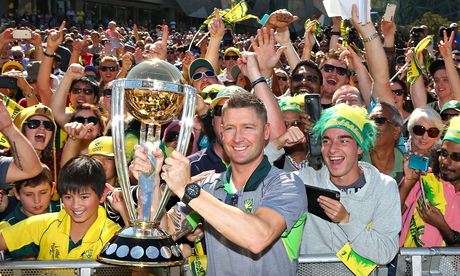
After six weeks and 49 matches, the best team won the World Cup, which generally ought to be the idea of a global tournament in any sport. If it was a six-week marathon, beginning in Christchurch and Melbourne on Valentine’s Day, then those who always saw Australia as having the all-round playing strength in depth, including a battery of pace bowlers unmatched anywhere, to overcome anyone when it really came down to it, were merely vindicated and those who thought otherwise just dreamers.
Brendon McCullum and his New Zealand team have been the most superb ambassadors not only for their country but for the game of cricket but in the end it was a bridge too far. They were outgunned, happily conceded as much, and no disgrace in that.
Between the two finalists, along with the losing semi-finalists South Africa and India, not to mention, at the other end of the scale, the associate nations of Ireland, Scotland, UAE and Afghanistan, the 50-over game has received a massive fillip.
If the format was perceived to be an increasing irrelevance in the burgeoning world of T20, and an encumbrance on the international schedules, then the manner in which this tournament has been played has been a showcase for the ODI format, where a narrative can be played out.
The chance for redemption is a great part of sport, be it cricket, five-set grand slam tennis, football or whichever: think of the way in which twice, in the semi-final at Eden Park and then in the final, Grant Elliott helped turn around the New Zealand innings, rebuilding after early setbacks. T20 can offer thrills and spills but it does not allow sporting heroism such as that.
However it is on the back of T20 cricket, particularly that involving franchises (is there a case for abandoning international T20 altogether?) that the players have made the format into the spectacle it is. What was once viewed as impossible has become commonplace as batsmen realised the restriction of orthodox batting was the emperor’s new clothes. Over the years, from Mark Greatbatch, through Sanath Jayasuriya and Romesh Kaluwitharana, to McCullum, Chris Gayle, David Warner, Glenn Maxwell and the genius AB de Villiers, different rules have been set.
This tournament has seen 38 centuries scored – two of them, by Gayle and Martin Guptill, doubles. When, in the final, Tim Southee hit his first ball, from Mitchell Johnson, back over the bowler’s head, it was to register the 462nd and penultimate six of the tournament, by no means a disproportionate number of them on the postage stamp pitches in New Zealand. Gayle alone hit 26.
As a result, bowlers suffered, but this served to highlight the skill shown by the man of the tournament, Mitchell Starc, whose 22 wickets, the same as Trent Boult, came at only 10 runs each, a remarkable achievement.
There is a sense that it is because of the batting bombardment, the tournament has been a success, not just in the crowds that numbered in excess of one million on host soil, but globally where, for example, the India v Pakistan group match is said to have been watched by a quarter of a billion in India and more than one billion worldwide, making it the most viewed single day’s sporting event in history.
Clearly, on a fundamental scale, the attraction is the hitting, and bowlers such as Starc have been rare. Commercially (and, sorry to bring this up) power hitting sells, and never mind that one of the finest matches of the competition was the low-scoring group match between Australia and New Zealand at Eden Park.
But in the aftermath of his triumph on Sunday, Michael Clarke, Australia’s captain, was only reiterating a widely held view that overall the game has become disproportionately loaded against the bowlers, from the fielding restrictions right through to the excess weight of the bails carrying the LED lights, which several times, including when Steve Smith was batting in the final, have failed to be dislodged.
Allowing an extra fielder out of the inner circle would mean captains could set fields without telegraphing their intentions and would encourage spinners more. Using a single ball through the innings would increase the chances of reverse swing (the two-ball rule was brought in largely because a single one got dirty and had to be changed too often). Both these things need serious consideration.
The biggest controversy though has surrounded the proposed format for the next World Cup, to be staged in England in 2019. It is intended this will feature 10 teams: the hosts plus the seven top-ranked teams as at 30 September 2017, and then two teams from a qualifying tournament in Bangladesh the previous year, which will include associate nations, and affiliates. The 10-team competition would include teams ranked nine to 12 and the top six teams from world cricket league division one. It means the World Cup could go ahead without a single member of the associates who have so enhanced this edition. That would be devastating for them, no matter how intense the qualification tournament might be. The exposure the four associate nations received, and with it the recognition of the huge increase in playing standards, was beyond price.
After Afghanistan played England in Sydney, their coach Andy Moles offered an articulate and heartfelt plea for the status quo. The Champions Trophy, he said, is for the elite teams, and the World Cup is the shop window for the game. Anyone who watched the magnificent spectacle of his fast bowler, Shapoor Zadran, rampaging in almost from the boundary edge, war paint on and hair flying would surely endorse this. From the swinging bats of Gayle and Guptill and the swinging deliveries of Starc and Boult, right down to this overt demonstration of sheer exuberant passion for the game, there has been no finer image of what cricket can mean.
How 2015 rewrote cricket World Cup history
Total runs
2015: 22,293 (48 matches)
2011: 19,986 (49 matches)
2007: 19,800 (51 matches)
2003: 18,873 (52 matches)
Total sixes
2015: 463
2011: 258
2007: 373
2003: 266
Total fours
2015: 2,170
2011: 1,902
2007: 1,808
2003: 1,793
Most sixes
2015: C Gayle (WI) 26
2011: R Taylor (NZ) 14
2007: M Hayden (Aus) 18
2003: S Ganguly (Ind) 15
Centuries
2015: 38
2011: 24
2007: 20
2003: 21
Highest strike rate (min 100 runs)
2015: B McCullum (NZ) 188.50
2011: K Pollard (WI) 150.00
2007: S Watson (Aus) 170.58
2003: R Powell (WI) 156.94
Number of batsmen with strike rate of over 100 (min 100 runs)
2015: 33
2011: 19
2007: 14
2003: 13
Overall tournament strike rate
2015: 88.97
2011: 78.39
2007: 75.87
2003: 72.63
Maidens bowled
2015: 182
2011: 206
2007: 274
2003: 301
*More maidens were bowled in 1979, when there were 14 matches, than there were bowled this year, when there were 48 matches
Overall bowling economy rate
2015: 5.55
2011: 4.91
2007: 4.84
2003: 4.63
Highest team score
2015: 417-6 (Aus v Afg)
2011: 370-4 (Ind v Ban)
2007: 413-5 (Ind v Bermuda)
2003: 359-2 (Aus v Ind)
Leading run scorers
2015: M Guptill 547 (9 innings)
2011: T Dilshan 500 (9 innings)
2007: M Hayden 659 (10 matches)
2003: S Tendulkar 673 (11 matches)
Highest scores
2015: M Guptill (NZ) 237
2011: V Sehwag (Ind) 175
2007: I Nazir (Pak) 160
2003: C Wishart (Zim) 172
Statistics compiled by John Ashdown







